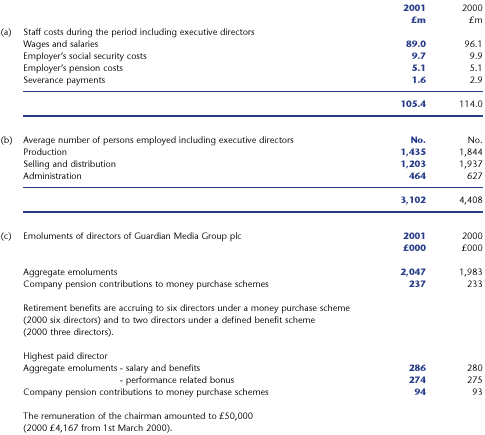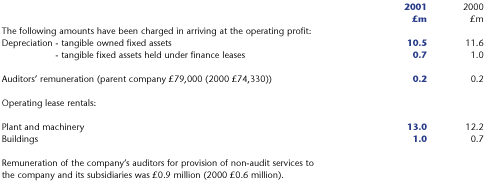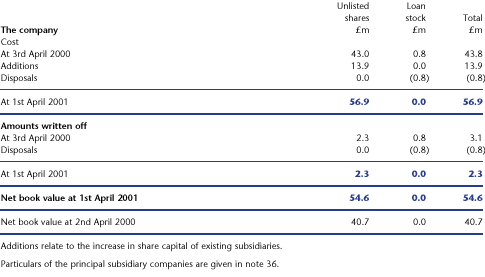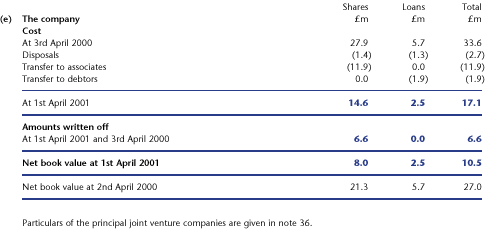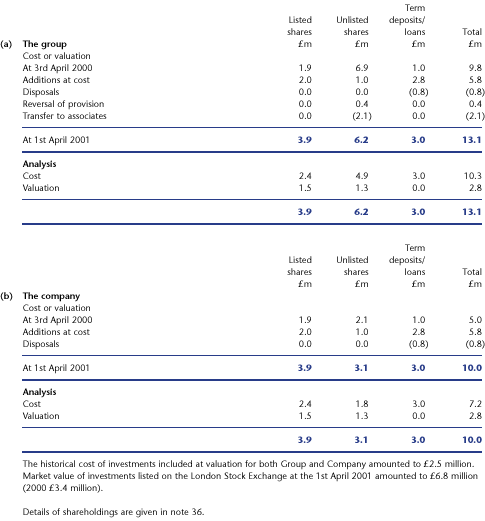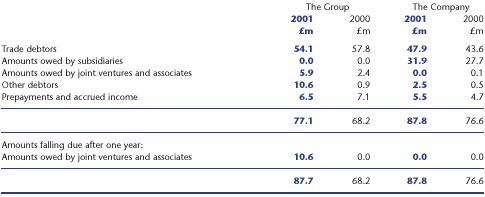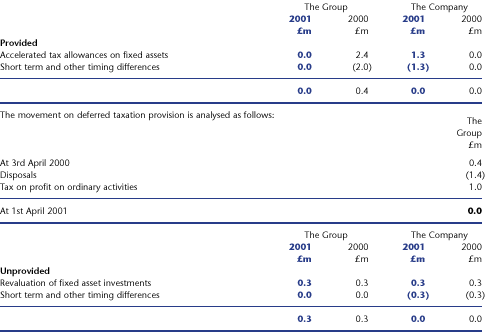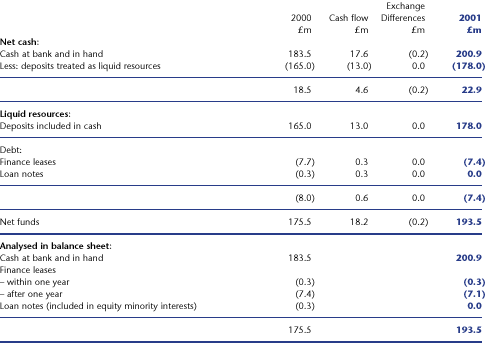

Notes Index
- Accounting policies
- Turnover
- Operating costs
- Staff costs
- Group operating profit
- Exceptional items
- Income from fixed asset investments
- Interest receivable and similar income
- Interest payable and similar charges
- Tax on profit on ordinary activities
- Profit of the parent company
- Intangible assets
- Tangible fixed assets
- Investment property
- Subsidiary companies
- Joint ventures
- Associates
- Other investments
- Current asset investments
- Stocks
- Debts
- Creditors: amounts falling due within one year
- Creditors: amounts falling due after more than one year
- Deferred taxation
- Called up share capital
- Profit and loss acount
- Equity minority interests
- Analysis of net funds
- Post balance sheet events
- Capital commitments authorised
- Contingent liabilities and financial commitments
- Operating lease and similar commitments
- Related party transactions
- Ultimate controlling party
- Pensions
- Subsidiaries and other companies
1. Accounting policies
Accounting basis
The accounts on pages 18 to 38 have been prepared in accordance with applicable accounting standards in the United Kingdom. Set out below is a summary of the more important Group accounting policies, which have been applied consistently. The accounts have been prepared on the historical cost basis as modified by the revaluation of certain assets.
Basis of consolidation
The consolidated profit and loss account and balance sheet include the accounts of the company and its subsidiary undertakings made up to 1st April 2001. The results of subsidiaries sold or acquired are included in the consolidated profit and loss account up to, or from, the date control passes. Intra-group sales and profits are eliminated fully on consolidation.
On acquisition of a subsidiary, all of the subsidiary's assets and liabilities that exist at the date of acquisition are recorded at their fair values reflecting their condition at that date. Goodwill is capitalised as an intangible asset and written off to the profit and loss account over its estimated useful life, a maximum period of 20 years. As permitted by Financial Reporting Standard 10, goodwill previously written off has not been reinstated. All changes to those assets and liabilities, and the resulting gains and losses, that arise after the Group has gained control of the subsidiary are charged to the post acquisition profit and loss account.
Joint ventures and associates
A company is treated as an associate when the Group has a participating interest in its equity share capital and exercises a significant influence over operating and financial policy. A company is treated as a joint venture when the Group holds an interest on a long term basis and jointly controls the company with one or more ventures under a contractual arrangement.
The Group's share of profits less losses of joint ventures and associates are included in the consolidated profit and loss account, and the Group's share of their net assets is included in the consolidated balance sheet. These amounts are taken from the audited accounts of the undertakings concerned. Where a joint venture or an associate has a different year end date to the Group, amounts from the latest audited accounts are adjusted to bring into line with the Group's year end date. The amounts involved are not material to the Group.
Depreciation and carrying value of fixed assets
Depreciation of tangible fixed assets has been calculated to write off
original cost by equal instalments over the estimated useful life of the
asset concerned. The principal annual rates used for depreciation are:
| Plant | 10% |
| Computer equipment | 20%-33% |
| Motor vehicles | 20% |
| Furniture, fixtures & fittings | 10% |
Freehold and leasehold buildings are written off over their estimated
useful lives or fifty years, whichever is the shorter.
Freehold land is not depreciated.
In accordance with Statement of Standard Accounting Practice 19, depreciation is not charged on freehold and long leasehold investment property which is included in the balance sheet at valuation; short leasehold investment property is written off over the period of the unexpired term.
Depreciation is charged on assets from the time they become fully operational.
The carrying value of fixed assets is reviewed for impairment if events or changes in circumstances suggest that their carrying amount may not be recoverable. When an impairment review is undertaken, the recoverable amount is calculated as the net present value of expected future cash flows of the relevant income generating unit.
Deferred taxation
Provision is made for deferred taxation, using the liability method, on all material timing differences to the extent that there is a reasonable probability that a taxation liability will crystallise in the foreseeable future.
Turnover
This represents amounts invoiced to customers (net of VAT) less discounts.
Stocks
Stocks are valued at the lower of cost and net realisable value. Cost is determined on a first in, first out basis.
Translation of foreign currencies
Assets and liabilities denominated in foreign currency are translated into sterling at the rate of exchange ruling at the year end and the results of overseas subsidiaries are translated at the average rate of exchange for the financial year. Exchange differences arising from the translation of the opening net investment in subsidiaries and on long term inter-company balances used to finance those investments, together with differences from the translation of the results of those companies at the average rate, are taken to reserves. Other exchange differences are taken to the profit and loss account.
Pensions
The majority of the Group's employees are members of defined contribution pension schemes operated by the parent company. The charge to the profit and loss account comprises the total contributions payable to the schemes in the period. The expected cost of pensions in respect of defined benefit schemes operated by Group companies is charged to operating profit so as to spread the cost of pensions over the service lives of employees. Variations from the regular cost are spread over the expected remaining service lives of current employees in the schemes. The cost is assessed in accordance with the advice of independent qualified actuaries.
Investment income
Income from bank and short term deposits is included in the accounts when receivable. Dividends are included in the accounting period in which they are received.
Finance and operating leases
Assets held under finance leases are capitalised at the fair value of the asset at the inception of the leases, with an equivalent liability categorised under creditors due within and after one year. Assets are depreciated over the shorter of the lease term and their estimated useful economic life. Finance charges are allocated to accounting years over the life of each lease to produce a constant rate of return on the outstanding balance. Costs in respect of operating leases are charged to operating profit when incurred.
Revaluation of investments
The valuations of investment property and certain other investments are reviewed annually and any major changes incorporated in the accounts. Listed investments are valued by the Directors at the lower end of the band within which market prices are expected to fluctuate. Unlisted investments are stated at Directors' valuation based on the Group's share of net asset value, except where this is below cost in which case a provision is made for any impairment in accordance with Financial Reporting Standard 11. Investment property is valued every three years by independent consultant surveyors.
Website development costs
Design and content costs of a website are capitalised if there is a reasonable expectation that the future economic benefits generated by the website are in excess of amounts capitalised. All other costs are written off as incurred. Website planning costs and expenditure to maintain and operate the website once developed, are charged against profits in the year in which they are incurred.
Sales are made substantially in the U.K.
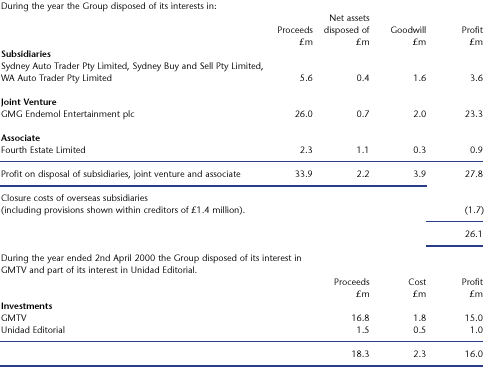
7. Income from fixed asset investments
![]()

8. Interest receivable and similar
income ![]()

9. Interest payable and similar
charges ![]()

10. Tax on profit on ordinary
activities ![]()
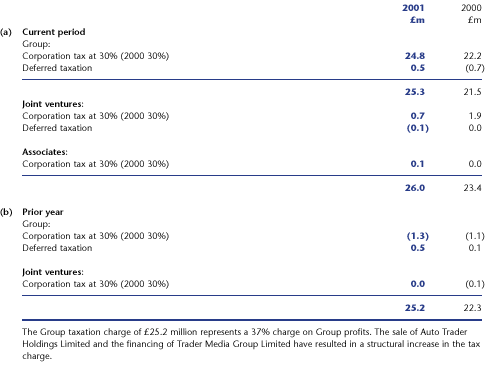
11. Profit of the parent
company ![]()
As permitted by section 228 of the Companies Act 1985, the profit and
loss account of the parent company is not presented as part of these accounts.
The Group results for the period include a profit of £25.3 million
(2000 profit £95.0 million) which is dealt with in the accounts
of the parent company.

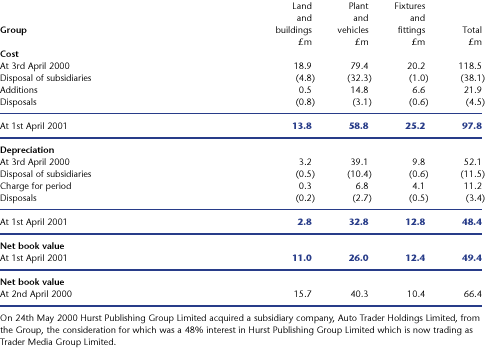
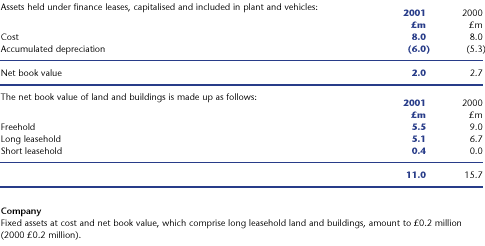
The current asset investment comprises redeemable preference shares issued during the year by GMG Investco Limited (a wholly owned subsidiary). The preference shares are redeemable within 12 months at the issuer’s option. Under the rights of the preference shares the proceeds receivable on redemption are E59.4 million. Hence they are accounted for as Euro denominated assets and retranslated at year end exchange rates, with any foreign exchange gains or losses taken to the profit and loss account. At the year end exchange rate of E1.6082 the amount of the investment was £37.0 million.
22. Creditors: amounts falling
due within one year ![]()
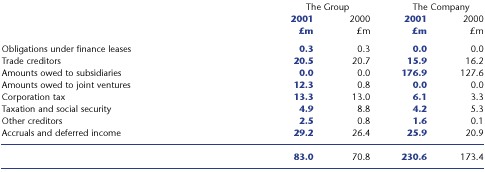
23. Creditors: amounts falling
due after more than one year ![]()
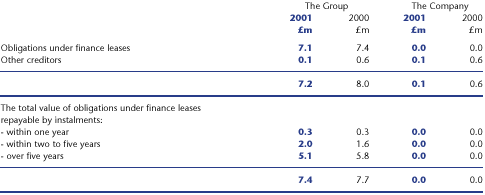
On the 31st May 2001 the Group disposed of its remaining interest in
Unidad Editorial.
On the 28th June 2001 the Group acquired Scot FM Limited for a total consideration
of £25.5 million.
30. Capital commitments authorised
![]()
Contracts for capital expenditure and investments for the Group amounted to approximately £9.7 million (2000 £4.1 million). There are no capital commitments in respect of the company (2000 £nil).
31. Contingent liabilities
and financial commitments ![]()
In the normal course of business the Group has given guarantees in respect
of commercial transactions.
These include:
(a) The company has given a guarantee to The Royal Bank of Scotland plc to secure the liabilities of certain of its subsidiary companies. At 1st April 2001 no subsidiary company had a bank overdraft (2000 £nil).
(b) The company has given joint and several guarantees and indemnities and sole guarantees in respect of certain leasing obligations of Trafford Park Printers Limited and Berkshire Press Limited amounting to £11 million.
(c) The company has given a sole guarantee on behalf of a subsidiary company in respect of a printing agreement with West Ferry Printers Limited amounting to a maximum of £25 million.
32. Operating lease and similar
commitments ![]()

33. Related party transactions
![]()
Transactions between subsidiary members of the Guardian Media Group plc are not required to be disclosed under Financial Reporting Standard 8 as these transactions are fully eliminated on consolidation. In the course of normal operations the Group has traded on an arms length basis with joint ventures, associates and other related undertakings, principally Trafford Park Printers and the Trader Media Group joint ventures. The aggregated transactions which are considered to be material and which have not been disclosed elsewhere in the financial statements are summarised below:
| £m | |
| Sales | 0.9 |
| Purchases | 16.8 |
| Loan repayments | 5.0 |
| Interest on loans | 21.9 |
| As at 1st April 2001, material balances outstanding in relation to these transactions were: | |
| £m | |
| Loans | 246.7 |
| Interest on loans | 16.5 |
During the year Guardian Media Group plc paid £90,000 to seven members of the Scott Trust in relation to their duties as Trustees. A further £239,000 was paid to three of the Trustees, none of whom are directors of the Group, for services rendered to Guardian Newspapers Limited and paid on a normal arms length basis. No members of the board received additional remuneration for services as a Trustee.
34. Ultimate controlling
party ![]()
The ultimate controlling party of the Group is the Scott Trust which owns 100% of the issued share capital of Guardian Media Group plc.
The majority of the Group’s employees are members of defined contribution
pension schemes operated by the company. The Group also contributes to
a small number of pension schemes which are of the defined benefit type.
These defined benefit schemes are insignificant in relation to the Group’s
overall pension arrangements. Pension scheme assets are held in separate
trustee administered funds. The total pension charge for the Group is
shown in note 4(a).
The most recent triennial actuarial valuations of the defined benefit pension schemes stated that the assets of the schemes were sufficient to cover the liabilities as at the date of valuation. The actuaries’ recommendations on the level of funding are being followed.
36. Subsidiaries and other companies
![]()
The principal activity of the subsidiaries, joint ventures and associates is the dissemination of news, information and advertising matter by way of print and other media. The following information relates to those subsidiary companies, which in the opinion of the directors, principally affected the results or financial position of the Group. The subsidiary companies are incorporated in Great Britain and registered in England and Wales except where noted.
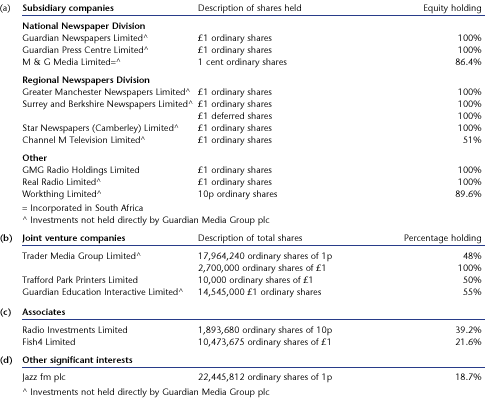
All the above companies are incorporated in Great Britain and registered in England and Wales and operate principally in their country of incorporation.

